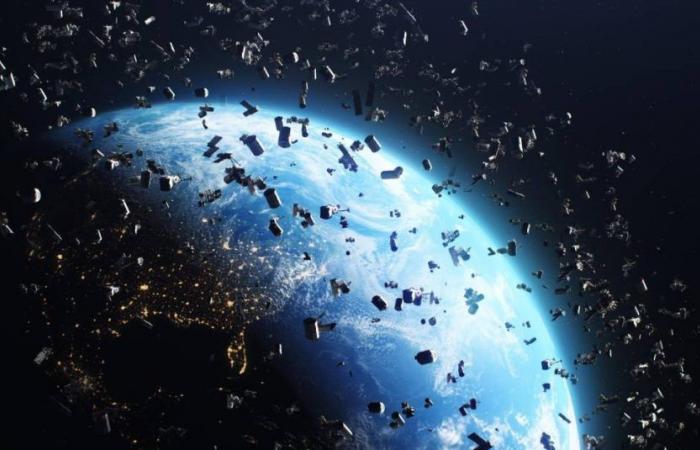06:08 PM
In March 2021, the National Aeronautics and Space Administration (NASA), used the robotic arm of the International Space Station, from where released a pallet of aging batteries, throwing about 2,600 kilos of garbage into space in 2021, according to the European newspaper The country.
Three years later, on March 8, 2024, A fragment of this charge passed through the ceiling and floor of Alejandro Otero’s home in Naples, Florida. This incident has led the Oteros to present a historic lawsuit against NASA, which could establish a significant legal precedent.
You may be interested in: NASA tested laser technology for future communication using pet photos
The Otero family, represented by attorney Mica Nguyen Worthy of the firm Cranfill Sumner, has filed a formal complaint against NASA. The lawsuit includes property damage not covered by insurance, compensation for business interruption, compensation for emotional distress and the costs of third-party assistance. Local media estimate the amount sought at more than $80,000 (about 75,000 euros).
The object that caused the damage is an Inconel metal alloy cylinder, approximately 10 centimetres high and 4 centimetres in diameter, weighing 700 grams. After analysis, NASA confirmed that the object was part of the flight support equipment used to mount batteries on the cargo pallet of the International Space Station. This fact has led NASA to investigate detail the incident to update their atmospheric reentry models.
Space debris is a growing problem due to the increase in space traffic, as the lawyer stated in a statement from the law firm in which she announced the claim, which he describes as “historic” and which will serve to establish legal bases for this type of problem.
Low Earth orbit is filled with millions of pieces of garbage, including rocket parts, inactive satellites and pieces of spacecraft. These objects can reach speeds of up to 29,000 kilometers per hour, posing a significant danger to space operations and life on Earth.
The European Space Agency (ESA) It is estimated that there are more than a million fragments of space junk of more than a centimeter and 130 million of more than a millimeter in Earth orbit. These fragments, especially the larger ones, have the potential to cause catastrophic damage to space assets.
You may be interested: 65 years ago the future began with the Mercury Seven, the first NASA astronauts
The Otero family’s claim has been filed under the Federal Tort Claims Act (FTCA), allowing citizens to sue the government for negligence. NASA has six months to respond to this claim, as reported by the European media.
Worthy stressed that American citizens should not have to base their claims on theories of negligence when the government has agreed to be “absolutely responsible” under international treaties for damage caused by space objects.
Worthy noted that if this incident had occurred in another country, The United States would be responsible for paying for damages under the Convention on International Liability for Damage Caused by Space Objects. We therefore call on NASA to treat American citizens with the same standard of responsibility and to appropriately compensate the Otero family.
This case underscores the urgent need to address the problem of space debris and its potential impacts on Earth. The Oteros’ lawsuit against NASA could set an important precedent for future cases and emphasizes the need for more effective measures to manage and reduce space debris.
The international community is already taking action, such as Zero Waste Charter signed by twelve European countries, to improve the sustainability of space activities and protect both space assets and life on Earth.
The space debris challenge
Space debris is a growing challenge that threatens both space missions and communication and navigation systems on Earth.
According to the European Space Agency (ESA), there are currently more than 36,500 objects larger than 10 cm orbiting the Earth, around a million fragments between 1 and 10 cm, and approximately 130 million particles smaller than 1 cm.
The impact of this waste is not just theoretical. On average, it detect more than 400 satellite fragmentation events per year, which increases the amount of space debris and the risk of collisions. A notable example was the 2009 incident, when the Russian satellite Cosmos 2251 collided with the Iridium 33 communications satellite, generating thousands of dangerous fragments.
In addition to the risk of collision, space debris can cause significant damage. NASA estimates that the International Space Station must perform collision avoidance maneuvers at least once a year to prevent impacts with space debris. In 2021, the ISS had to adjust its orbit three times to avoid potentially catastrophic collisions.
The cost of mitigating and preventing the effects of space debris is considerable. Satellite companies invest millions in developing shielding technologies and evasion maneuvers.
Read more: Amazing video: This is what the total solar eclipse over North America looked like, as seen from space
For example, the Whipple shield, used on the ISS to protect against impacts of micrometeorites and space debris, It has been crucial in preventing damage, but represents a significant cost in the development and maintenance of the station.






